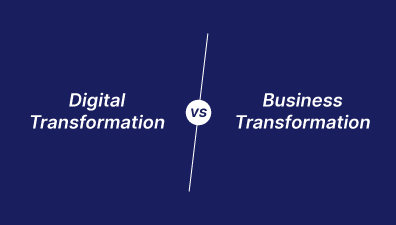In today’s business world, digital transformation has become a hot topic. Many companies are eager to adopt new technologies and move away from traditional methods but often fail to achieve their goals. While it is certainly important to embrace new technologies, it is even more crucial to focus on the needs of your customers and partners. By tracking your progress and identifying areas of improvement, you can ensure that your transformation efforts are on track and making a positive impact on your business.
In this blog post, we will discuss some of the most important digital transformation KPIs for assessing the success of digital transformations. We will also provide tips on how to track these KPIs effectively. Check it out to find the right digital transformation KPI for your business
Table of Contents
10 Digital Transformation KPIs for success measurement
Return on Digital Investments
Revenue from new technology can be a great way to measure the success of its implementation. By tracking how much revenue is generated from new digital technology, you can get a clear picture of its profitability. This digital transformation metric is similar to return on digital investments, but it specifically looks at revenue in relation to new technologies introduced.
This KPI is often used when implementing a new digital purchasing method, such as eCommerce sales or a new online store. It could also be used for recurring or subscription payments for software or a platform. By tracking this metric, you can get a clear idea of whether or not your new technology is successful and profitable.
Customer Experience

As any business knows, customer experience is essential. In the age of the internet, customers have more choices than ever before, and if they are not happy with their experience with your company, they will take their business elsewhere. For this reason, it is essential to track customer experience closely when going through a digital transformation.
Three popular customer experience metrics are the Customer Effort Score (CES), the Customer Satisfaction (CSAT) Score, and the Net Promoter Score (NPS).
- The CES measures how much effort a customer needs to put in to complete a task, usually through surveys.
- The CSAT score tracks how happy customers are with their service or a specific component of your product.
- The NPS measures how likely customers are to recommend your product or service to others.
Furthermore, If you’re looking for ways to gauge how well your marketing efforts are paying off, customer engagement and conversion metrics can be valuable indicators.
Workforce Productivity
Another popular digital transformation KPIs examples for all businesses is workforce productivity. As any business owner knows, productivity is essential to success. The more productive employees are, the more work they can get done in a given period of time. As a result, companies have always been searching for ways to increase employee productivity. In recent years, new technology and processes have promised to help employees get more done in less time. But while these tools can sometimes deliver on that promise, they can just as often become complicated and convoluted, actually making teams less productive.
The key is to be clear about your productivity metrics before you roll out any new tools or processes. Only then can you be sure that you’re making improvements that will have a positive impact on your bottom line.
Cloud Application Deployments

As we become more and more reliant on digital devices and tools, it’s no surprise that one of the most popular business transformations today is moving to the cloud. But how can you tell if your company’s cloud deployment is successful? One way is to measure it.
There are many factors to consider when measuring cloud deployments, such as data security, uptime, and performance. By collecting data on things like how often data is accessed and how quickly employees can find the information they need, you can get a good idea of how well your cloud solution is working and identify areas for improvement.
Revenue From New Digital Services
Active usage metrics is a valuable tool for understanding how users interact with your technology. By tracking things like daily active users, conversion rates, and abandon rates, you can get a clear picture of what works well and what needs improvement. For example, if you see that your conversion rate is low, that may indicate that your software is too complicated or confusing to use. On the other hand, a high abandonment rate might mean that users are getting frustrated and giving up before they can complete a task. Active usage of digital transformation KPIs can help you identify these problems so that you can make the necessary changes to improve your technology.
Cost-Benefit Analysis
Just like any other business decision, digital transformation initiatives should be driven by a cost-benefit analysis. This process entails comparing the costs and rewards of different potential scenarios to see which is most likely to be successful. When it comes to digital transformation, there are a number of factors to consider. For example, you’ll need to think about the cost of new technology, the time it will take to implement it, and the potential return on investment.
By carefully considering all of these factors, you can make sure that your digital transformation strategy is worth the investment. And, by doing a cost-benefit analysis for each component of your digital transformation, you can ensure that you’re focusing on the areas that will give you the biggest ROI.
Operational Improvement

It’s also important to consider how new software is affecting productivity. To get a clear picture of this, it’s necessary to count the number of processes that now run on new software and compare it to the overall level of output. This will give you some insight into how well the software is being used and where there may be room for improvement. In many cases, you’ll find that simplifying processes, providing greater training, or introducing automation can have a big impact on productivity. By taking the time to measure these important digital transformation KPIs, you can ensure that your business is getting the most out of its new software.
Reliability & Availability
In the age of the Internet, a strong online presence is crucial for building a positive brand reputation. If your website or social media platforms are constantly unavailable, it gives customers the impression that you don’t care about their experience. This can damage your reputation and deter potential customers from doing business with you. Additionally, if the equipment and software your team uses are constantly failing, it creates a ripple effect of issues. Not only does it hurt productivity, but it also makes it difficult to provide the excellent customer support that is essential for building a strong reputation.
Some of the common metrics providing this insight include:
- Mean Time to Failure (MTTF): measures the average amount of time that a website is down before it is fixed
- Mean Time to Resolve (MTTR): measures the average amount of time it takes to resolve a problem once it has been detected
- Mean Time Before Failure (MTBF): measures the average amount of time that a website remains up and running before experiencing any problems
To avoid these problems, it’s important to have a robust digital transformation plan that takes into account the reliability of your online presence and internal solutions. By taking these steps, you can safeguard your reputation and ensure that your business is able to thrive.
How to Choose the Right Digital Transformation KPIs?
Your business’ ERP system is the backbone of your company. It manages everything from your financials to your human resources to your inventory. So, when you’re looking for an ERP system, you want one that not only offers powerful features and functionality but also provides the ability to measure digital transformation KPIs and present metrics and comparisons. A good ERP system will give you visibility into every area of your business and help you understand how a change or problem in one department can impact the rest of the organization. With an ERP system in place, you can make informed decisions that will help your business run more efficiently
Magenest is a leading provider of ERP solutions, with experience in implementing systems for companies of all sizes. We offer both Odoo and Adobe ERP solutions, depending on the needs of our clients. Contact us today to learn more about how we can help your company achieve its digital transformation goals.











